Altered spontaneous brain activity patterns in patients with diabetic retinopathy using amplitude of low-frequency fluctuation
2022-03-05WenQingShiMouXinZhangLiYingTangLeiYeYuQingZhangQiLinBiaoLiYiShaoYaoYu
INTRODUCTION
Chronic complications of diabetes are the main causes of death and disability with diabetes, and its morbidity may be related to many factors, among which diabetic retinopathy (DR) is the main cause of blindness and visual impairment[1]. The incidence of DR is increasing worldwide mainly because of the longevity of diabetes patients[2]. A large proportion of adults who are over the age of 40 are affected by DR.Early manifestations of DR are mainly aneurysms, bleeding spots, hard exudation,cotton buds, venous beading, intravascular microvascular abnormalities, and macular edema[3]. According to the presence of retinal neovascularization, we can divide DR into proliferative DR (PDR) and non-proliferative DR (NPDR). In PDR, retinal damage stimulates neovascular growth. Neovascular growth is detrimental to the retina, which can cause fibrosis and even retinal detachment. Neovascularization can also enter the vitreous, which will lead to vitreous hemorrhage[4] (Figure 1). Recently, there has been increasing evidence that similar microvascular lesions happen in the brains of diabetics. Autopsy results in patients with chronic diabetes have shown that their brains developed a severe microvascular disease and neurological disease[5]. Pearce
[6] pointed out that a diagnosis of DR suggests an increased risk of brain parenchymal disease in diabetic patients. These diabetic vascular and neurological complications interact for a long time, and we believe that the effects of diabetic complications on the brain's microvasculature are often overlooked. The previous gold standard for a DR diagnosis relied mainly on fundus fluorescence imaging, but it is not suitable for people with skin test allergies and poor liver and kidney function.However, there has been little analysis of changes in brain function in DR and its relationship to clinical manifestations in the eye to date. We hypothesized that the presence of DR may suggest central damage to the brain neural network caused by the existence of a microvascular system, while central damage in the brain neural network is an early predictor of DR.
Honest day s work, fer a honest day s pay, he intoned, solemnly, and sounding the h in honest - causing secret amusement in my brothers and myself.
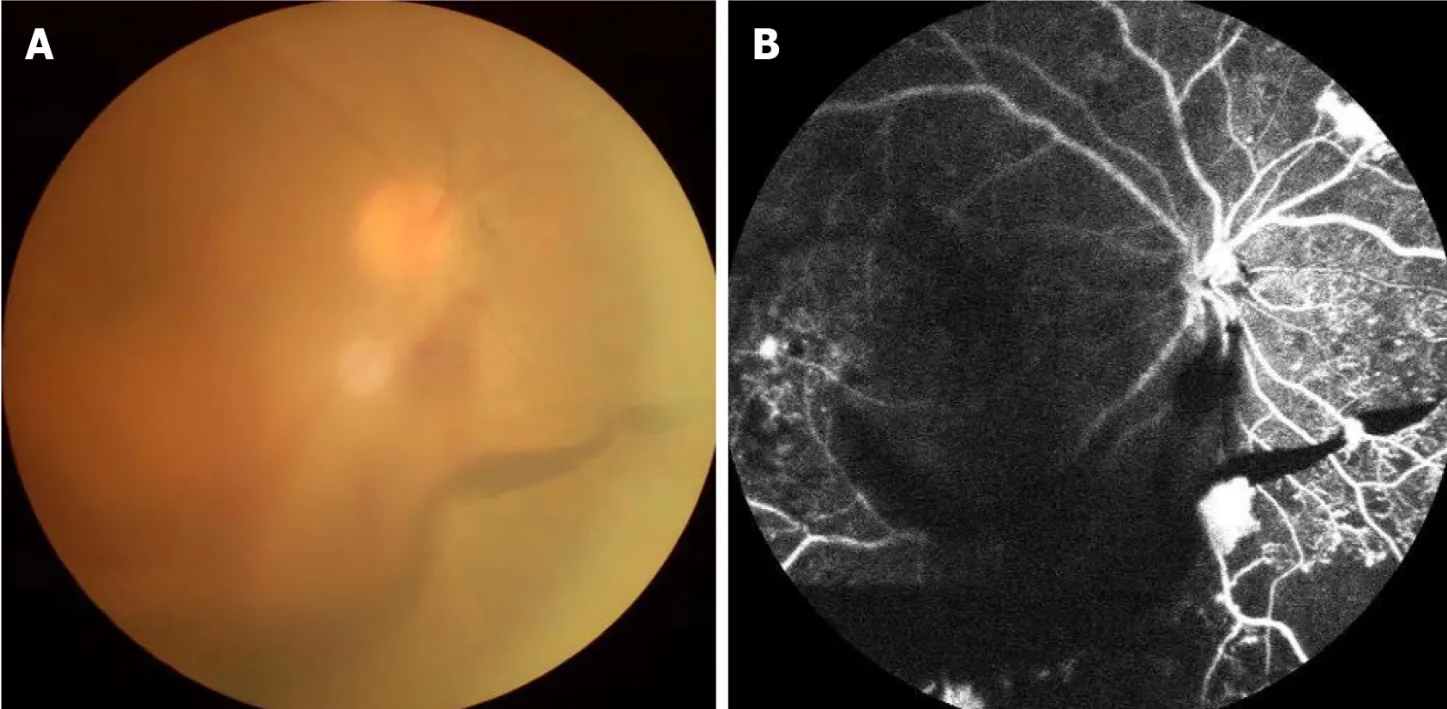
Functional magnetic resonance imaging (fMRI) makes it possible to observe specific differences in the brain neural network[7] and studying these changes can enhance our knowledge of diseases. Thus, fMRI neuroimaging is of great interest for exploring the function of the central nervous system, considering it can monitor neural activity in the brain and can also provide some new explanations for the pathophysiological mechanism and pathogenesis of disease[8]. Resting-state fMRI (rs-fMRI) is a functional magnetic resonance technique used in resting-state functional network research. It explores the human nervous system through magnetic resonance imaging, which is simpler than task-state fMRI[9]. By combining electroneurophysiological records with fMRI, studies have demonstrated that low frequency (0.0-0.08 Hz) fluctuations (LFF) in blood oxygen level dependent (BOLD) fMRI signals are closely associated with spontaneous neuronal activity[10]. ALFF is one of the methods used to evaluate fMRI analysis of resting brain activity[11,12]. It reflects the intensity of local spontaneous brain activity at rest and brain endogenous/background neurophysiological processes.We have used the ALFF method to assess the neurological status and brain changes in some patients with eye diseases; for example, optic neuritis[13], glaucoma and strabismus[14,15], Parkinson’s disease[16], in our previous studies.
He is almost as light as the bubble, and he raises himself on his hind12 legs, and wants to be taken into the swing; but it does not stop, and the dog falls; then he barks and gets angry
MATERIALS AND METHODS
Subjects
There was a positive correlation between the best-corrected visual acuity (BCVA)values of the affected eyes in the DR group and bilateral calcarine signal values (
=0.938,
= 0.001). Figure 5 shows the specific details.
Traditionally, the cerebellar function is considered to involve physical balance and motor coordination[31]. However, because of the development and application of neuroimaging technology in recent years, we have a better understanding of the specific effect of the cerebellum, especially its posterior lobe, in emotional processing[32].
This study was conformed with the Declaration of Helsinki and had formal approval from the Medical Ethics Committee of the First Affiliated Hospital of Nanchang University. All the volunteers signed informed consent forms and were allowed to ask questions after learning about the purpose, content, and potential risks of this research.
Diagnostic criteria
The International Council of Ophthalmology in Sydney defined the international classification standard of DR in 2002, and the details are as follows: (1) In the early stage of the disease, after mydriasis, ophthalmoscopy revealed diffuse microaneurysms and small petechia in the posterior pole of the retina; some patients exhibited white or yellow exudate with complaints of blurry vision; (2) Retinopathy was found in the fundus under fundus angiography machine; (3) Using fundus fluorescein angiography, the number of microadenomas in the fundus was obviously increased and were beyond the results of fundus microscopy and there was capillary dilation around the retina, increased permeability, and increased abnormalities such as bleeding or neovascularization[17]. A patient with any of these symptoms was diagnosed as DR.
MRI parameters
The cerebellum’s posterior lobe is located between the primary fissure and the posterolateral fissure. In earlier studies, lesions of the posterior lobe could cause severe damage to spatial memory, emotional regulation, and executive functions[33,34].Nitschke
[35] showed that the cerebellum is associated with the movement of the eyeballs. Kresyun[36] found that using a transcranial magnetic to stimulate the cerebellum of DR patients helped with the recovery of the retina's ability to respond to light stress. Previous studies employing positron emission tomography found that patients with social anxiety had abnormal cerebellum signals with increasing cerebralblood flow, which were illustrative. All these studies showed that abnormal activity in the cerebellum was related to anxiety[37,38]. In this study, we found an increase in the ALFF values of the left and right posterior cerebellar lobe. While we cannot prove that DR patients have anxiety, we can propose the hypothesis that anxiety may occur in DR patients with visual and even cognitive disorders.
fMRI data analysis
Our previous reports described how to analyze fMRI data. First, we used MRIcro software (www.mricro.com) to expel broken data. During magnetization equilibration,the first ten time points were discarded. Data Processing Assistant for the advanced edition of Resting-State fMRI (DPARSFA 4.0, http://rfmri.org/DPARSF) software was used for the form conversion of digital imaging communications in medicine (DICM),the correction of head motion, slice timing, realignment, spatial normalization, fullwidth smoothing with a Gaussian kernel of 6 mm × 6 mm × 6 mm at half-maximum,detrending, and nuisance covariates regression, based on the rs-fMRI data analysis toolkit (REST, http://www.restfmri.net). The other images were corrected time differences and micromotions during scanning. During the fMRI examination, subjects were excluded if they had more than three degrees of motion or if the maximum excursion in the x, y or z direction exceeded 3 mm.
We used the SPSS version 22.0 (IBM Corporation, Armonk, NY, United States) with an independent samples
-test to analyze the cumulative clinical variables between HCs and the DR group. A
value < 0.05 showed statistical significance. We compared functional data with a two-sample
-test using REST software. Through Gaussian random field theory, the statistical thresholds for multiple comprehensively compared voxel levels were set as
< 0.001. Alphasim was corrected for cluster sizes > 30 voxels at a
< 0.01 level.
The calcium troponin crack is a deep groove on the inside surface of the occipital lobe.The upper and lower parts of the sulcus are the main cortical projection areas of vision.Impulses from the upper retina are transmitted above the sulcus, and visual information from the lower retina is projected below the sulcus. Impulses from the macular area are transmitted above and below the posterior third of the sulcus. This structure is an anatomical marker or landmark.
Brain-behavior correlation analysis
According to the results of ALFF, REST software was applied to divide different brain areas of these groups into areas of interest. The mean ALFF values in each region of interest were obtained by calculating the average ALFF values of all voxels. Using GraphPad Prism 9.0 (Graph Pad Software Inc., San Diego, CA, United States), the correlation between the average ALFF values of multiple brain regions in the DR group and the clinical data was evaluated (
< 0.05).
Statistical analysis
We used linear regression analysis to remove spurious covariates and their time derivatives from various other sources, including the signal from the region of interest(ROI) to the central white matter region[18]. It should be noted that, in this study, the data showed that the global signal did not shrink, as was the case in our former study[19,20], which may have been caused by the elimination of global signals during preprocessing of the data at rest[21,22]. The fMRI images were unified to the Montreal Neurological Institute spatial standard using a standard echoplanar imaging template after correction for head motion, while the images were resampled to a resolution of 3 mm × 3 mm × 3 mm. To reduce the effect of diversity between participants, we divided the ALFF of each voxel by the average whole-brain ALFF value for each subject.
RESULTS
Demographics and behavioral results
No statistically significant differences were found between the two groups in weight (
= 0.982) or age (
= 0.975). The mean ± SD of DR duration was 253.18 ± 76.22 d(Table 1).
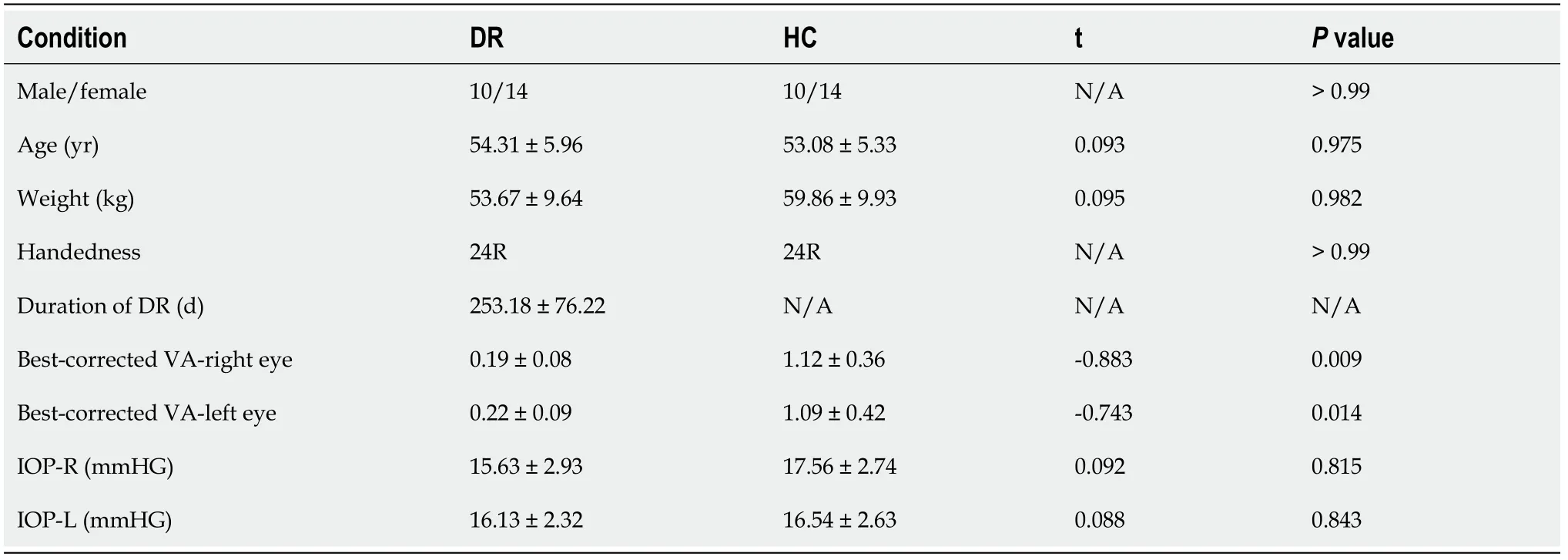
ALFF differences
Compared with the results in the HCs, the ALFF values of the DR patients were remarkably lower in the bilateral calcarine fissures, but higher in the left and right posterior lobes of the cerebellum as well as the right anterior cingulate gyrus (Figures 2 and 3 and Table 2).

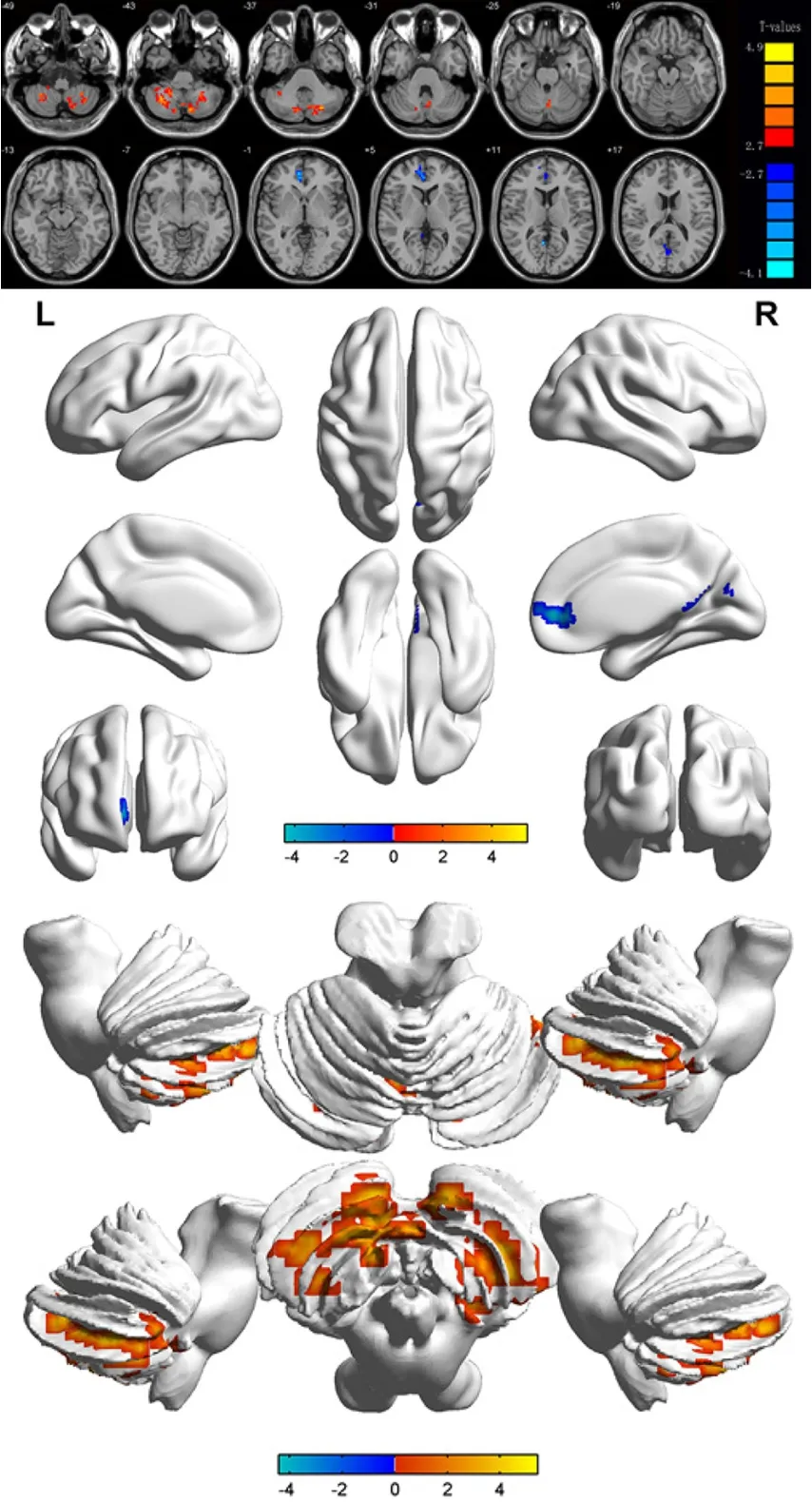
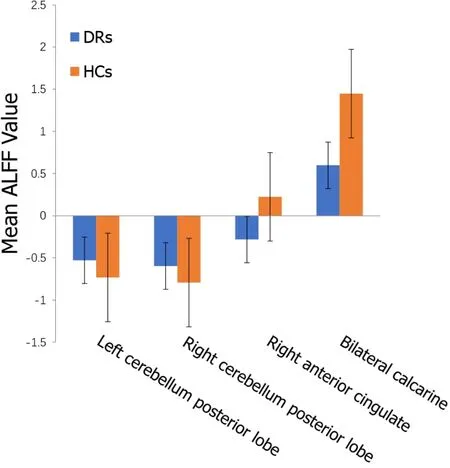
Receiver operating characteristic curves
Receiver operating characteristic (ROC) curves were applied to analyze the mean ALFF values of different cerebral areas. The diagnosis rate was displayed in the area under the curve (AUC). The AUCs of ALFF values for different cerebral areas were as follows: Right anterior cingulate gyrus (0.080,
< 0.001), left posterior lobe of the cerebellum (0.938,
< 0.001), right posterior lobe of the cerebellum (0.947,
< 0.001;Figure 4A), and the bilateral calcarine fissures (0.893,
< 0.001; Figure 4B).
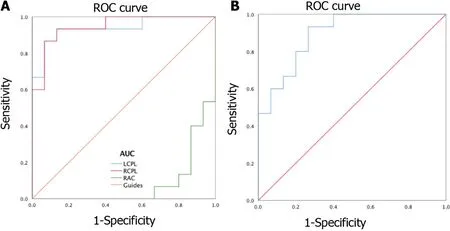
Correlation analysis
We randomly selected 24 DR patients who visited the First Affiliated Hospital of Nanchang University, Nanchang, China. All the subjects met the following inclusion criteria: (1) Diagnosis of type 2 diabetes; (2) Diagnosis of PDR; (3) Fasting blood glucose controlled at approximately 7-10 mmol/L and blood glucose after a meal at 10-14 mmol/L; (4) No abnormality of the cerebral parenchyma on cranial MRI; (5)Without other ocular diseases bilaterally (
, retinal detachment, glaucoma,amblyopia, ocular trauma, optic nerve disease); (6) Right-handed; and (7) Untreated PDR. The exclusion criteria were: (1) Smokers; (2) No other eye diseases; (3) Pregnant or lactating women; (4) Other diabetes complications; (5) Congenital systemic disease;(6) Mental illness (such as depression, memory impairment, cognitive impairment, and schizophrenia); and (7) Cerebral infarction diseases or cerebral vascular malformations. Twenty-four healthy controls (HCs) matched in age, educational status, and sex were enrolled. Both the DR group and HCs met the following criteria: (1) MRI showed no obvious damage or deformity of the brain parenchyma; (2) No history of brain infarction, cardiovascular disease or cerebral hemorrhage; (3) No evidence of drug or alcohol addiction; and (4) Were able to tolerate an MRI examination.
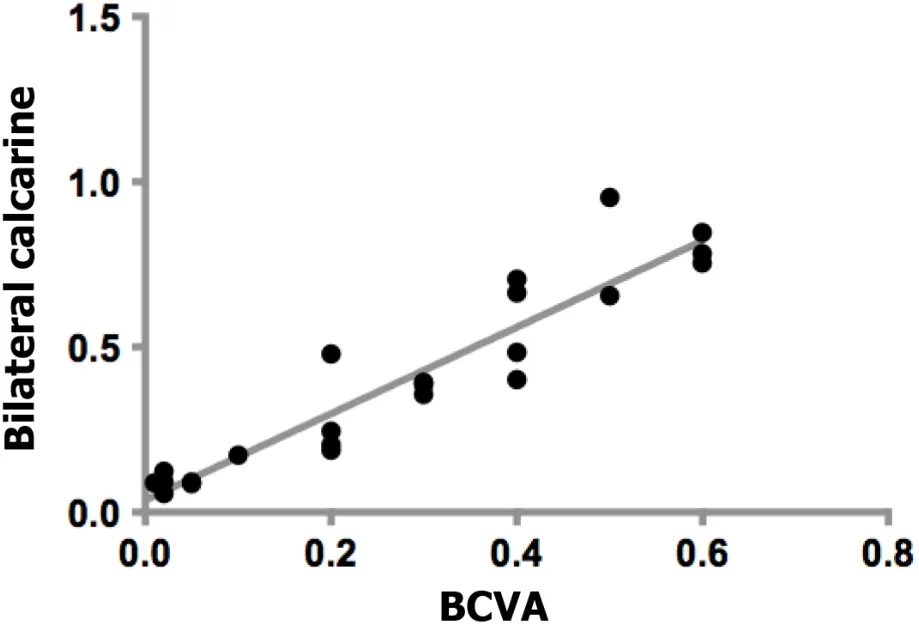
DISCUSSION
DR comprises microvessel damage, which is caused by diabetes mellitus. It is one of the most important causes of visual impairment in young adults[23]. DR is found in 33% of the diabetic patients in the world and is considered an increased risk for systemic vascular complications[24]. The retinal anatomy, physiology and embryological features are similar to cerebral small blood vessels of the brain[25].Research has shown fundus arteriosclerosis has a positive correlation with cerebral atherosclerosis (
< 0.01)[26], and many diabetes neuroimaging markers of brain abnormalities have a relationship with microvascular disease. Previous studies have shown that the retinal pathological changes in the microcirculation (for example, the Gunn arteriovenous phenomenon, microaneurysms, soft exudate, and retinal hemorrhages) may be associated with markers of cerebral microvascular disease[27].
I realized that the funny, crunching10 noise I heard each night as I climbed the stairs was really my knees. I had seriously considered adding potty training to my resume as one of my greatest accomplishments11. Bran flakes12 had become a part of my daily routine -- and not because they were my favorite cereal. I held Tupperware parties just so I could count how many friends I had.
To our knowledge, this is the first study designed to explore spontaneous cerebral activity changes in DR patients using the ALFF method. Compared with the values in the HCs, the DR patients showed significantly lower ALFF values in the bilateral calcarine fissures, but higher values in the left and right posterior lobes of the cerebellum and the right anterior cingulate gyrus (Figure 6). The ALFF method has already been successfully applied in several eye diseases (Table 3) and it is expected that the application has good prospects for the future.
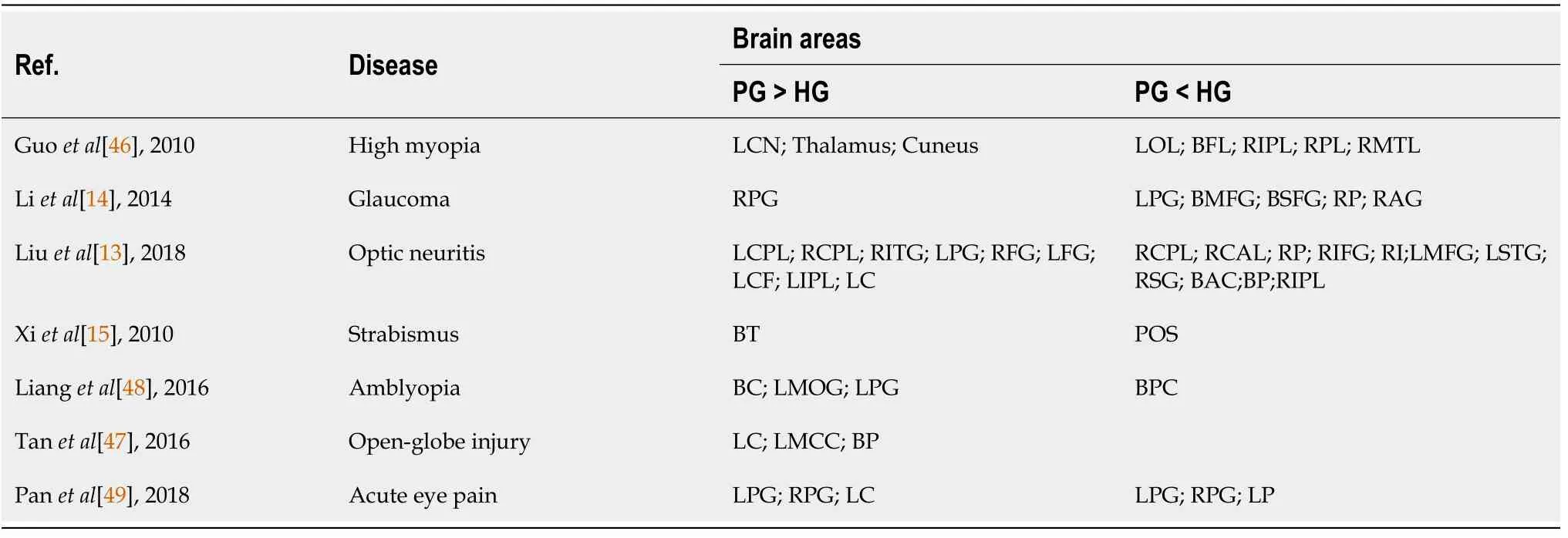
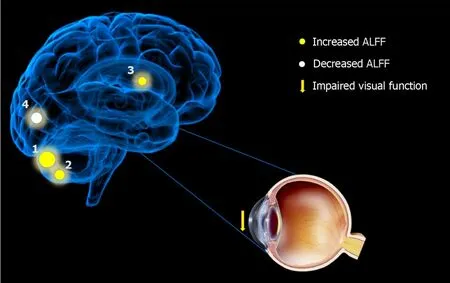
Analysis of the decreased ALFF values of DR patients
One afternoon, Cocoa started acting5 strangely. I was sitting on the floor playing with him, when he started pawing and sniffing6 at the right side of my chest. He had never done anything like this ever before, and I told him, “No.” With Cocoa, one “no” is usually sufficient, but not that day. He stopped briefly7, then suddenly ran toward me from the other side of the room, throwing his entire weight -- eighteen pounds -- at the right side of my chest. He crashed into me and I yelped8 in pain. It hurt more than I thought it should have.
“When you have reached your fifteenth year,”9 said the grand-mother, “you will have permission to rise up out of the sea, to sit on the rocks in the moonlight, while the great ships are sailing by; and then you will see both forests and towns
These two lived happy and contentedly24 for a long while, when one evening, as the young man was looking from the window, he saw on a mountain that lay out beyond the town a great bright light
Previous reports[28] have shown that diabetes affects the microvascular system and leads to cerebral small vascular disease (SVD; Figure 7). The underlying mechanism of visual impairment in DR may involve a compromised arterial blood supply to the visual region that results from SVD. As fMRI has shown, bilateral activation of the visual cortex and eyeball movement can be caused by stimulation of the visual system[29]. Previous studies[30] have shown that prolonged poor glycemic control manifests with basement membrane thickening, tight junction disruption, and pericyte loss,leading to dysregulation of the vascular tone and endothelial cell proliferation, which can lead to microaneurysm formation and ultimately spot and speckle hemorrhages.In this study, we found that there were decreased ALFF values bilaterally in the calcarine fissures of DR patients, which may be related to the impaired vision in these patients. We examined BCVA in both eyes of the patients and found that patients with DR had significantly lower BCVA compared to HCs (
< 0.05; Table 1). Our study observed that there was a positive correlation between the BCVA values of the eyes of the DR group and the signal values of the bilateral calcarine (
= 0.938,
= 0.001). It may be speculated that the decreased signal values of the bilateral calcarine fissures may reflect damage to visual processing in the patients.
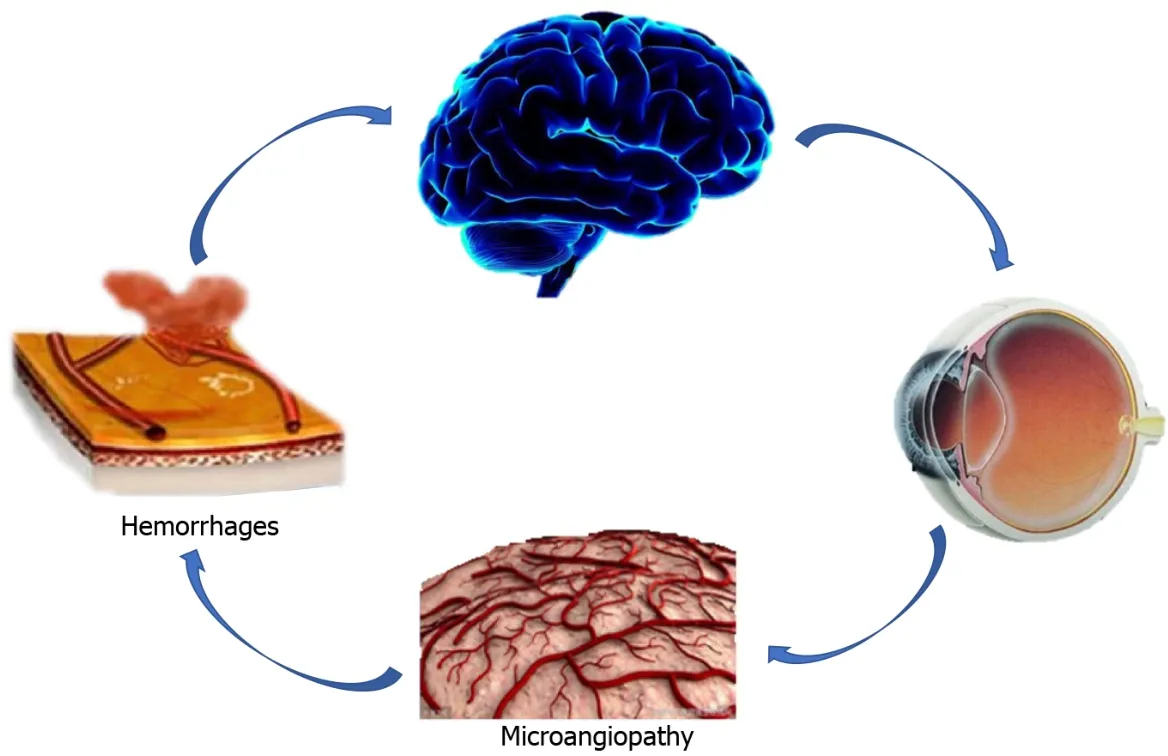
Analysis of the increased ALFF values in DR
That is a sensible little pig, replied his mother, looking fondly at him. I will see that the three houses are got ready at once. And now one last piece of advice. You have heard me talk of our old enemy the fox. When he hears that I am dead, he is sure to try and get hold of you, to carry you off to his den11. He is very sly and will no doubt disguise himself, and pretend to be a friend, but you must promise me not to let him enter your houses on any pretext12 whatever.
In this research, we performed MRI scans using 3-Tesla MRI scanners (Siemens,Munich, Germany). All participants were asked to close their eyes and maintain natural breathing until the end of the scan. We applied a gradient echo sequence of pulses of the 3D variation to obtain function data, and the parameters were as follows:176 structural images (acquisition matrix = 256 × 256, field of view = 250 mm × 250 mm, TR = 2 s, TE = 2.26 ms, cycle time = 1900 ms, thickness = 1.0 mm, gap = 0.5 mm,flip angle = 9°). We acquired 240 functional images in total (acquisition matrix = 64 ×64, field of view = 220 mm × 220 mm, thickness = 4.0 mm, gap = 1.2 mm, cycle time =2000 ms, echo time = 30 ms, flip angle = 90°, 29 axial). A typical scan took 15 min to complete.
The anterior cingulate cortex (ACC) is a vital part of the limbic system of the brain.It has extensive and numerous fibrous connections to the cortex and subcortical structures and is involved in the regulation of emotional and motor functions[39]. In a previous study, researchers observed structural defects in the ACC in many depressed patients[40]. Yu
[41] evaluated diabetic patients using the SF-36 Health-Related Quality of life (HRQL) and anxiety disorders, and they found that there was a statistically significant difference in impaired HRQL (SF-36 summary score) in DR patients compared to the control group (
< 0.05). Clinically, DR patients may also have serious psychosocial problems[42]. Depression is not uncommon in DR patients and it has a negative impact on their condition. However, in recent years, an increasing amount of evidence from electrophysiology[43], functional imaging[44], and behavioral studies[45] have shown that the ACC is closely related to the management of pain. The ACC can be activated by nociceptive and contextual stimuli, and it can participate in pain management, especially affective pain. The neural mechanisms of the ACC’s involvement in effective pain have not been clarified. The specific neural mechanism remains to be studied in the future.
CONCLUSION
This study demonstrated that there are some abnormal spontaneous brain activities in DR patients. The findings using these new techniques offer information that may help to explain the nerve mechanisms underlying the clinical manifestations of DR patients and contribute to improved clinical diagnoses.
ARTICLE HIGHLIGHTS
Research background
Diabetic retinopathy (DR) is one of the most common complications of diabetes mellitus; however, to date, there has been little analysis of the changes in brain function in patients with DR and their relationship to the clinical manifestations in the eye. This study is the first to examine brain changes in patients with DR using the amplitude of low-frequency fluctuation (ALFF).
Research motivation
The current diagnosis of DR mainly involves fundus fluorescein imaging for examination, and the direct connection between eyes, other manifestations, and the brain is still unknown. In this study, we employed the ALFF technique to investigate abnormal brain activity in DR patients and its relationship with clinical characteristics.Our research may help with understanding how DR disease develops.
Research objectives
We investigated the underlying ALFF of local characteristics of spontaneous brain activity in DR patients and their relationship with behavioral performance. Our findings suggested possible mechanisms of clinical manifestations and behavior in DR patients.
Research methods
Twenty-four DR patients and 24 healthy controls (HCs) matched for both age and sex were recruited. We measured and recorded the average ALFF values of DR patients and HCs and then classified them using receiver operating characteristic (ROC)curves.
Research results
We found that the ALFF values of both the left and right cerebellum posterior lobe and the right anterior cingulate gyrus were remarkably higher in the DR patients compared with the HCs, but DR patients also had lower values in the bilateral calcarine. ROC curve analysis of different brain regions demonstrated high accuracy of area under the curve analysis. However, there was no remarkable relationship between ALFF mean values for different regions and clinical presentations of DR patients.
The week that followed was filled with surprises. It seemed the McDonald house had suddenly been invaded by an army of invisible elves, and good things were happening everywhere. Kelly would walk into her room at bedtime and find her little blue nightgown neatly15 laid out and her bed turned down. Someone cleaned up the sawdust under the workbench without being asked. The jelly blobs disappeared magically from the kitchen counter after lunch one day while Mother was getting the mail. And every morning, while Eric was brushing his teeth, someone crept quietly into his room and made his bed. It wasn’t made perfectly16, but it was made.
Research conclusions
We hypothesized that DR may lead to alterations in visual cortical activity. Our results showed altered spontaneous activity in three regions of the brain in patients with DR.Abnormalities in low-frequency amplitudes in the brain may be associated with alterations in contralateral best-corrected visual acuity and depression in DR patients.These findings may suggest possible mechanisms of clinical manifestations and behaviors in DR patients.
Research perspectives
Our finding that DR may lead to multiple low-frequency amplitude frequency changes in the brain may facilitate our exploration of pathological mechanisms and disease progression in DR patients. However, the drawback is that the sample size was too small. Future studies should increase the sample size in order to ensure the validity of our findings.
1 Gunasekeran DV, Ting DSW, Tan GSW, Wong TY. Artificial intelligence for diabetic retinopathy screening, prediction and management.
2020; 31: 357-365 [PMID: 32740069 DOI: 10.1097/ICU.0000000000000693]
2 Pascolini D, Mariotti SP. Global estimates of visual impairment: 2010.
2012; 96:614-618 [PMID: 22133988 DOI: 10.1136/bjophthalmol-2011-300539]
3 Zhu XR, Yang FY, Lu J, Zhang HR, Sun R, Zhou JB, Yang JK. Plasma metabolomic profiling of proliferative diabetic retinopathy.
2019; 16: 37 [PMID: 31160916 DOI:10.1186/s12986-019-0358-3]
4 Su JB, Zhao LH, Zhang XL, Cai HL, Huang HY, Xu F, Chen T, Wang XQ. HbA1c variability and diabetic peripheral neuropathy in type 2 diabetic patients.
2018; 17: 47 [PMID:29598819 DOI: 10.1186/s12933-018-0693-0]
5 Usuelli V, La Rocca E. Novel therapeutic approaches for diabetic nephropathy and retinopathy.
2015; 98: 39-44 [PMID: 25447794 DOI: 10.1016/j.phrs.2014.10.003]
6 Pearce I, Simó R, Lövestam-Adrian M, Wong DT, Evans M. Association between diabetic eye disease and other complications of diabetes: Implications for care. A systematic review.
2019; 21: 467-478 [PMID: 30280465 DOI: 10.1111/dom.13550]
7 Liu H, Wang X. Correlation of iron deposition and change of gliocyte metabolism in the basal ganglia region evaluated using magnetic resonance imaging techniques: an
study.
2016; 12: 163-171 [PMID: 26925133 DOI: 10.5114/aoms.2016.57593]
8 Meijer FJ, Goraj B. Brain MRI in Parkinson's disease.
2014; 6: 360-369[PMID: 24896211 DOI: 10.2741/E711]
9 Fox MD, Greicius M. Clinical applications of resting state functional connectivity.
2010; 4: 19 [PMID: 20592951 DOI: 10.3389/fnsys.2010.00019]
10 Cakir Y. The effects of Alzheimer's disease related striatal pathologic changes on the fractional amplitude of low-frequency fluctuations.
2020; 23: 1347-1359 [PMID: 32749154 DOI: 10.1080/10255842.2020.1801653]
11 Xing XX, Zheng MX, Hua XY, Ma SJ, Ma ZZ, Xu JG. Brain plasticity after peripheral nerve injury treatment with massage therapy based on resting-state functional magnetic resonance imaging.
2021; 16: 388-393 [PMID: 32859803 DOI: 10.4103/1673-5374.290912]
12 Rosenbaum D, Int-Veen I, Kroczek A, Hilsendegen P, Velten-Schurian K, Bihlmaier I, Fallgatter AJ,Ehlis AC. Amplitude of low frequency fluctuations (ALFF) of spontaneous and induced rumination in major depression: An fNIRS study.
2020; 10: 21520 [PMID: 33299001 DOI:10.1038/s41598-020-78317-y]
13 Liu Y, Jiang X, Butzkueven H, Duan Y, Huang J, Ren Z, Dong H, Shi FD, Barkhof F, Li K, Wang J.Multimodal characterization of gray matter alterations in neuromyelitis optica.
2018; 24:1308-1316 [PMID: 28741987 DOI: 10.1177/1352458517721053]
14 Li T, Liu Z, Li J, Tang Z, Xie X, Yang D, Wang N, Tian J, Xian J. Altered amplitude of lowfrequency fluctuation in primary open-angle glaucoma: a resting-state FMRI study.
2014; 56: 322-329 [PMID: 25525176 DOI: 10.1167/iovs.14-14974]
15 Xi S, Yao J, Zhang S, Liu R, Wu L, Ye X, Zhang P, Wen W, Zhao C. Disrupted neural signals in patients with concomitant exotropia.
2020; 40: 650-659 [PMID: 32672862 DOI: 10.1111/opo.12715]
16 Kwak Y, Peltier SJ, Bohnen NI, Müller ML, Dayalu P, Seidler RD. L-DOPA changes spontaneous low-frequency BOLD signal oscillations in Parkinson's disease: a resting state fMRI study.
2012; 6: 52 [PMID: 22783172 DOI: 10.3389/fnsys.2012.00052]
17 Alzner E. International Congress of Ophthalmology — The World Meeting of Ophthalmologists,21.–25. April 2002, Sydney — Australien.
2002; 16: 189-190 [DOI:10.1007/BF03164300]
18 Fox MD, Snyder AZ, Vincent JL, Corbetta M, Van Essen DC, Raichle ME. The human brain is intrinsically organized into dynamic, anticorrelated functional networks.
2005; 102: 9673-9678 [PMID: 15976020 DOI: 10.1073/pnas.0504136102]
19 Kang HH, Shu YQ, Yang L, Zhu PW, Li D, Li QH, Min YL, Ye L, Zhou Q, Shao Y. Measuring abnormal intrinsic brain activities in patients with retinal detachment using amplitude of lowfrequency fluctuation: a resting-state fMRI study.
2019; 129: 681-686 [PMID:30499735 DOI: 10.1080/00207454.2018.1554657]
20 Wu YY, Yuan Q, Li B, Lin Q, Zhu PW, Min YL, Shi WQ, Shu YQ, Zhou Q, Shao Y. Altered spontaneous brain activity patterns in patients with retinal vein occlusion indicated by the amplitude of low-frequency fluctuation: A functional magnetic resonance imaging study.
2019;18: 2063-2071 [PMID: 31410162 DOI: 10.3892/etm.2019.7770]
21 Saad ZS, Gotts SJ, Murphy K, Chen G, Jo HJ, Martin A, Cox RW. Trouble at rest: how correlation patterns and group differences become distorted after global signal regression.
2012; 2:25-32 [PMID: 22432927 DOI: 10.1089/brain.2012.0080]
22 Zang YF, He Y, Zhu CZ, Cao QJ, Sui MQ, Liang M, Tian LX, Jiang TZ, Wang YF. Altered baseline brain activity in children with ADHD revealed by resting-state functional MRI.
2007; 29:83-91 [PMID: 16919409 DOI: 10.1016/j.braindev.2006.07.002]
23 Polack S, Yorston D, López-Ramos A, Lepe-Orta S, Baia RM, Alves L, Grau-Alvidrez C, Gomez-Bastar P, Kuper H. Rapid assessment of avoidable blindness and diabetic retinopathy in Chiapas,Mexico.
2012; 119: 1033-1040 [PMID: 22342012 DOI:10.1016/j.ophtha.2011.11.002]
24 Koch EAT, Nakhoul R, Nakhoul F, Nakhoul N. Autophagy in diabetic nephropathy: a review.
2020; 52: 1705-1712 [PMID: 32661628 DOI: 10.1007/s11255-020-02545-4]
25 Tso MOM, Jampol LM. Pathophysiology of hypertensive retinopathy.
1982; 89: 1132-1145 [DOI: 10.1016/S0161-6420(82)34663-1]
26 Reid IR, Bolland MJ. Controversies in medicine: the role of calcium and vitamin D supplements in adults.
2019; 211: 468-473 [PMID: 31680267 DOI: 10.5694/mja2.50393]
27 Wong TY. Is retinal photography useful in the measurement of stroke risk?
2004; 3:179-183 [PMID: 15029894 DOI: 10.1016/s1474-4422(04)00682-9]
28 Szcześniak D, Rymaszewska J, Zimny A, Sąsiadek M, Połtyn-Zaradna K, Smith EE, Zatońska K,Zatoński T, Rangarajan S, Yusuf S, Szuba A. "Cerebral small vessel disease and other influential factors of cognitive impairment in the middle-aged: a long-term observational cohort PURE-MIND study in Poland".
2021; 43: 279-295 [PMID: 33074422 DOI:10.1007/s11357-020-00271-4]
29 Dieterich M, Bauermann T, Best C, Stoeter P, Schlindwein P. Evidence for cortical visual substitution of chronic bilateral vestibular failure (an fMRI study).
2007; 130: 2108-2116[PMID: 17575279 DOI: 10.1093/brain/awm130]
30 Fang M, Selvin E. Thirty-Year Trends in Complications in U.S. Adults With Newly Diagnosed Type 2 Diabetes.
2021; 44: 699-706 [PMID: 33419932 DOI: 10.2337/dc20-2304]
31 Ferrari C, Oldrati V, Gallucci M, Vecchi T, Cattaneo Z. The role of the cerebellum in explicit and incidental processing of facial emotional expressions: A study with transcranial magnetic stimulation.
2018; 169: 256-264 [PMID: 29246845 DOI: 10.1016/j.neuroimage.2017.12.026]
32 Adamaszek M, D'Agata F, Ferrucci R, Habas C, Keulen S, Kirkby KC, Leggio M, Mariën P,Molinari M, Moulton E, Orsi L, Van Overwalle F, Papadelis C, Priori A, Sacchetti B, Schutter DJ,Styliadis C, Verhoeven J. Consensus Paper: Cerebellum and Emotion.
2017; 16: 552-576[PMID: 27485952 DOI: 10.1007/s12311-016-0815-8]
33 Stoodley CJ, Schmahmann JD. Functional topography of the human cerebellum.
2018; 154: 59-70 [PMID: 29903452 DOI: 10.1016/B978-0-444-63956-1.00004-7]
34 Schmahmann JD. The cerebellum and cognition.
2019; 688: 62-75 [PMID: 29997061 DOI: 10.1016/j.neulet.2018.07.005]
35 Nitschke MF, Arp T, Stavrou G, Erdmann C, Heide W. The cerebellum in the cerebro-cerebellar network for the control of eye and hand movements--an fMRI study.
2005; 148: 151-164 [PMID: 15661188 DOI: 10.1016/S0079-6123(04)48013-3]
36 Kresyun NV. The influence of deltalycyn and transcranial cerebellar stimulation upon recovery of retina after photo stress in patients with diabetic retinopathy.
2014;118: 1068-1073 [PMID: 25581971]
37 Kilts CD, Kelsey JE, Knight B, Ely TD, Bowman FD, Gross RE, Selvig A, Gordon A, Newport DJ,Nemeroff CB. The neural correlates of social anxiety disorder and response to pharmacotherapy.
2006; 31: 2243-2253 [PMID: 16525417 DOI: 10.1038/sj.npp.1301053]
38 Olexová L, Štefánik P, Kršková L. Increased anxiety-like behaviour and altered GABAergic system in the amygdala and cerebellum of VPA rats - An animal model of autism.
2016; 629:9-14 [PMID: 27353514 DOI: 10.1016/j.neulet.2016.06.035]
39 Bush G, Luu P, Posner MI. Cognitive and emotional influences in anterior cingulate cortex.
2000; 4: 215-222 [PMID: 10827444 DOI: 10.1016/s1364-6613(00)01483-2]
40 Webb CA, Weber M, Mundy EA, Killgore WD. Reduced gray matter volume in the anterior cingulate, orbitofrontal cortex and thalamus as a function of mild depressive symptoms: a voxel-based morphometric analysis.
2014; 44: 2833-2843 [PMID: 25066703 DOI:10.1017/S0033291714000348]
41 Yu Y, Feng L, Shao Y, Tu P, Wu HP, Ding X, Xiao WH. Quality of life and emotional change for middle-aged and elderly patients with diabetic retinopathy.
2013; 6: 71-74 [PMID:23549357 DOI: 10.3980/j.issn.2222-3959.2013.01.15]
42 Crosby-Nwaobi RR, Sivaprasad S, Amiel S, Forbes A. The relationship between diabetic retinopathy and cognitive impairment.
2013; 36: 3177-3186 [PMID: 23633523 DOI:10.2337/dc12-2141]
43 Yu W, Wu X, Chen Y, Liang Z, Jiang J, Misrani A, Su Y, Peng Y, Chen J, Tang B, Sun M, Long C,Shen J, Yang L. Pelvic Pain Alters Functional Connectivity Between Anterior Cingulate Cortex and Hippocampus in Both Humans and a Rat Model.
2021; 15: 642349 [PMID:34149369 DOI: 10.3389/fnsys.2021.642349]
44 Ito T, Tanaka-Mizuno S, Iwashita N, Tooyama I, Shiino A, Miura K, Fukui S. Proton magnetic resonance spectroscopy assessment of metabolite status of the anterior cingulate cortex in chronic pain patients and healthy controls.
2017; 10: 287-293 [PMID: 28203104 DOI:10.2147/JPR.S123403]
45 Boccard SG, Pereira EA, Moir L, Van Hartevelt TJ, Kringelbach ML, FitzGerald JJ, Baker IW,Green AL, Aziz TZ. Deep brain stimulation of the anterior cingulate cortex: targeting the affective component of chronic pain.
2014; 25: 83-88 [PMID: 24100411 DOI:10.1097/WNR.0000000000000039]
46 Guo MX, Dong HH, Zhang Y T. ALFF Changes in Brain Areas of Human with High Myopia Revealed by Resting-state Functional MRI.
2010; 1: 91-94
47 Tan G, Huang X, Ye L, Wu AH, He LX, Zhong YL, Jiang N, Zhou FQ, Shao Y. Altered spontaneous brain activity patterns in patients with unilateral acute open globe injury using amplitude of lowfrequency fluctuation: a functional magnetic resonance imaging study.
2016; 12: 2015-2020 [PMID: 27570455 DOI: 10.2147/NDT.S110539]
48 Liang M, Xie B, Yang H, Yu L, Yin X, Wei L, Wang J. Distinct patterns of spontaneous brain activity between children and adults with anisometropic amblyopia: a resting-state fMRI study.
2016; 254: 569-576 [PMID: 26245338 DOI:10.1007/s00417-015-3117-9]
49 Pan ZM, Li HJ, Bao J, Jiang N, Yuan Q, Freeberg S, Zhu PW, Ye L, Ma MY, Huang X, Shao Y.Altered intrinsic brain activities in patients with acute eye pain using amplitude of low-frequency fluctuation: a resting-state fMRI study.
2018; 14: 251-257 [PMID:29386898 DOI: 10.2147/NDT.S150051]
